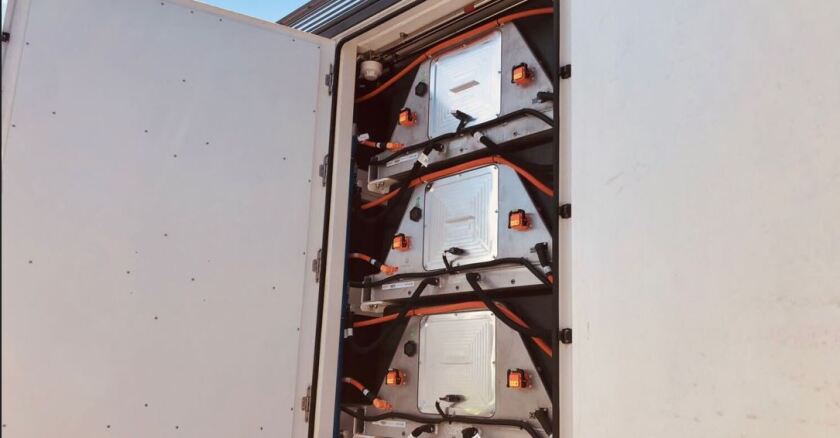Six battery storage containers owned and operated by local renewable energy company EnerSmart will deliver six megawatts and 12 megawatt-hours of energy by interconnecting with a nearby San Diego Gas & Electric substation, promising to relieve strain on the state's power system and reduce the chances of blackouts.
The Chula Vista storage facility provides stabilizing services for the California Independent System Operator, or CAISO for short, that manages the electric grid for about 80 percent of the state and a small part of Nevada.
"All this is very localized versus a huge project that's in the middle of the desert," said James Beach, EnerSmart's co-founder and managing partner. "So this will really help keep the lines here (in the Chula Vista area) ... keep the frequency level stabilized."
Battery storage has taken on a higher profile in recent years as more renewable sources of power have come onto California's power system.
Solar production is abundant during the day but practically vanishes after sunset or when smoke and clouds obscure the skies. And when the wind doesn't blow, production from wind farms peters out. Energy storage — particularly from batteries — is seen as a key way to fill the gaps.
Storage facilities take solar power generated during the day and discharge the electricity later, especially from 4 p.m. to 9 p.m. when California's grid is under the most stress and energy prices are at their highest. The stored power can also help during heat waves and when wildfires break out, reducing the chances of power outages.
Plus, battery storage sites do not emit greenhouse gases, as the state seeks to derive 90 percent of its electricity from carbon-free sources by 2035 and 100 percent by 2045.
Four years ago, California counted just 250 megawatts of battery storage available to the CAISO. But the system operator reported on July 1 that the number had grown to 5,600 megawatts.
And the amount of battery storage fully integrated into the electric grid isexpected to increase to 19,500 megawatts by 2035 and reach 52,000 megawatts by 2045.
Based in Solana Beach with nine employees, EnerSmart has 11 storage projects in various stages of development in San Diego County (including the Chula Vista facility), totaling 156 megawatts.
Meanwhile, SDG&E owns and operates seven battery storage projects and in the past two months opened two new facilities — a 40-megawatt, 160-megawatt-hour site in Falbrook and a facility in the desert of Imperial Valley with a capacity for 131 megawatts and 524 megawatt-hours over a four-hour period.
The utility plans to soon build six more battery storage facilities, ranging in size from nine megawatts to 20 megawatts.
"In the 1970s environmentalism was about stopping bad things from happening," said Rep. Scott Peters, D- San Diego, who took part in the official opening of the Chula Vista battery project Tuesday. "Now, you think about all the stuff we have to build — whether it's battery storage, high-voltage transmission, utility-scale solar, offshore wind, hydrogen pipelines — there's a lot of stuff we have to build."
EnerSmart's 6,500-square-foot location in Chula Vista uses lithium iron phosphate batteries, the same technology used in many electric school buses.
In some instances, fires have broken out at battery storage facilities but EnerSmart officials say lithium iron phosphate batteries are fire resistant.
The batteries were made by BYD, a huge company headquartered in Shenzhen, China, that is one the world's leaders in manufacturing rechargeable batteries.
Battery systems make sounds when they are in use — mostly during the day when electricity demand is high — and EnerSmart officials have installed noise mitigation designs at the Chula Vista location that they say will enclose and deflect sound away from neighbors who live nearby. The facility sits behind a fence 10 feet high, with walls on all four sides.
The Chula Vista project is privately owned, operated and financed by EnerSmart, which is fully responsible for all of its costs. SDG&E ratepayers, EnerSmart officials say, do not pay for it.
Beach said the project cost about $7 million. So how does the company make money? By selling the stored energy onto the grid.
"Ninety-five percent of the time we turn the battery over to the system operator (the CAISO) to help control supply and demand and we get paid a certain rate," Beach said. "It changes every hour, it's all market-based. Another way we get paid is by charging (the batteries) when prices are cheap and dispatching when prices are high."
Some $78.2 million in financing for all of EnerSmart's 11 storage projects came from the North American Development Bank and Siemens Financial Services.
Based in San Antonio, Texas, the North American Development Bank is a binational institution created by the U.S. and Mexican governments to bankroll environmental and energy infrastructure projects located within 60 miles of the border.
"We've done these types of projects throughout the border, on both sides," said the bank's chief operating officer John Beckham. "From Tijuana and San Diego all the way to Brownsville and Matamoros, we'll do any of these projects ."
The North American Development Bank has financed 40 renewable energy projects since 2011 — 17 in Mexico and 23 in the U.S., including 12 in California.
©2023 The San Diego Union-Tribune, Distributed by Tribune Content Agency, LLC.














